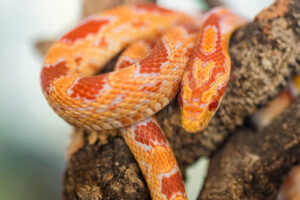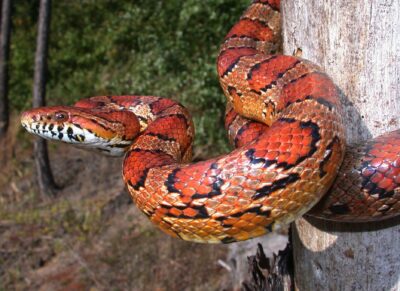Ever wondered about the lifestyle of those mesmerizing corn snakes that have become a fixture in the reptile enthusiast community? Well, buckle up because we’re about to dive into the age-old question: Are corn snakes nocturnal?
Picture this: your pet corn snake, adorned with its vibrant patterns, slithering around its enclosure, and you can’t help but wonder if it’s more of a night owl. Nocturnality, or being active during the night, is a thing for many snakes, but is it the case for our charming corn snake friends?
Are corn snakes nocturnal?

Corn snakes are not strictly nocturnal; they are crepuscular or sometimes considered diurnal. Crepuscular animals are most active during dawn and dusk, while diurnal animals are primarily active during the day.
In the case of corn snakes, they exhibit behavior that aligns with both crepuscular and diurnal patterns. They may be more active during the early morning or late afternoon when there is low light, as well as during the night, but they also move around during the day, especially in search of food or basking for warmth.
Their activity patterns might vary based on various factors such as temperature, season, and individual behavior. In captivity, they might adjust their activity patterns according to their environment and feeding schedule set by their caregivers.
So, while they’re not strictly nocturnal, corn snakes do display a range of activity throughout the day and night, being most active during twilight periods.
Diurnal vs. Nocturnal Behavior of corn snakes
Corn snakes are generally considered crepuscular or sometimes diurnal, but they can also exhibit nocturnal behavior under certain circumstances. Let’s explore the differences between diurnal, crepuscular, and nocturnal behavior:
- Diurnal (Daytime):
-
- Diurnal animals are most active during the day.
- They may hunt, explore, and engage in other activities while it’s light outside.
- Corn snakes do exhibit some diurnal behavior, especially when basking for warmth or hunting.
- Crepuscular (Dawn and Dusk):
-
- Crepuscular animals are most active during the dawn and dusk, which are the periods of low light.
- Corn snakes are often considered crepuscular, showing increased activity during these low-light periods.
- This behavior is thought to be related to hunting and avoiding predators.
- Nocturnal (Nighttime):
-
- Nocturnal animals are primarily active during the night.
- While corn snakes are not strictly nocturnal, they may become more active during the night, especially when it comes to hunting for prey.
Factors Influencing Corn Snakes’ Activity
Several factors can influence the activity of corn snakes, affecting when and how they behave. These factors include:
- Temperature:
-
- Corn snakes are ectothermic, meaning their body temperature is influenced by the environment.
- They become more active when temperatures are within their preferred range, which is typically between 75°F and 85°F (24°C to 29°C).
- Basking in the warmth of the day or a heat source is common for regulating their body temperature.
- Lighting Conditions:
-
- Corn snakes often exhibit crepuscular behavior, being more active during dawn and dusk when light levels are lower.
- Lighting conditions can influence their activity, and they may become more active during the low-light periods.
- Seasonal Changes:
-
- The changing seasons can impact the behavior of corn snakes.
- They may become more active during the breeding season, which is typically in the spring.
- Hunting and Feeding:
-
- Corn snakes are carnivorous and may become more active when they are hungry.
- They often hunt for prey during their active periods.
- Humidity:
-
- Corn snakes require a certain level of humidity for proper shedding of their skin.
- In captivity, they may become more active when seeking areas with appropriate humidity levels.
- Territorial Behavior:
-
- Corn snakes may exhibit territorial behavior, especially during the breeding season.
- Males may become more active as they search for females.
- Habitat and Enclosure Setup:
-
- The design and furnishings of their enclosure can influence their activity.
- Providing hiding spots, climbing opportunities, and a proper temperature gradient can affect their behavior.
- Health and Age:
-
- The health and age of a corn snake can impact its activity level.
- Younger snakes might be more active and explorative, while older individuals may be more sedentary.
- Environmental Changes:
-
- Sudden changes in the environment, such as relocation or changes in enclosure conditions, can affect their behavior.
Understanding and providing for these factors in captivity can contribute to the overall well-being and natural behavior of corn snakes. It’s essential to create an environment that mimics their natural habitat and meets their specific needs.
Enclosure Setup for Encouraging Natural Behavior

Creating a suitable enclosure for corn snakes is crucial to encourage their natural behaviors, provide for their physical and mental well-being, and support activities like hunting, hiding, and thermoregulation.
Here are some guidelines for setting up a corn snake enclosure:
- Substrate:
-
- Use a substrate that allows for burrowing and provides a comfortable surface for shedding. Aspen shavings, cypress mulch, or coconut coir are suitable options.
- Hiding Places:
-
- Include multiple hiding spots to mimic their natural environment. Half logs, commercial hides, or cardboard boxes can serve as shelters.
- Place hides on both the warm and cool sides of the enclosure to allow for temperature regulation.
- Climbing Opportunities:
-
- Corn snakes are known to climb, so provide branches or other climbing structures in the enclosure.
- This allows them to explore vertical space and engage in natural behaviors.
- Temperature Gradient:
-
- Create a temperature gradient in the enclosure, with a warm side (around 85°F or 29°C) and a cooler side (around 75°F or 24°C).
- Use heat sources like under-tank heating pads or heat lamps to achieve the proper temperature gradient.
- Lighting:
-
- While corn snakes are not as reliant on specific lighting conditions as some other reptiles, providing a natural light cycle with a day/night pattern can be beneficial.
- Use a low-wattage UVB bulb if your enclosure is large or lacks natural sunlight.
- Humidity:
-
- Maintain proper humidity levels, especially during shedding. A humidity box filled with damp moss can help snakes during the shedding process.
- Provide a water bowl for drinking and soaking.
- Secure Enclosure:
-
- Ensure the enclosure has secure locks to prevent escape.
- Corn snakes are known to be good escape artists, so make sure the lid or door is secure.
- Enrichment:
-
- Add fake plants, branches, or other items to create a visually stimulating environment.
- Occasionally change the layout to provide mental stimulation.
- Feeding Area:
-
- Designate a specific area for feeding. This can help the snake associate that area with feeding time and reduce stress during handling.
- Regular Maintenance:
-
- Keep the enclosure clean by regularly removing waste and soiled substrate.
- Monitor the temperature, humidity, and other environmental conditions regularly.
Remember to research and consider the specific needs of your corn snake’s subspecies, as there can be some variations in environmental requirements. Providing a well-designed enclosure that supports their natural behaviors is essential for the health and happiness of captive corn snakes.
Do corn snakes prefer nighttime activity?
Corn snakes are primarily crepuscular, which means they are most active during the dawn and dusk hours when light levels are lower. While they may exhibit increased activity during low-light periods, it’s important to note that corn snakes are not strictly nocturnal (active primarily at night). Instead, their activity patterns are more aligned with crepuscular behavior.
In captivity, corn snakes may adjust their activity patterns based on factors such as temperature, humidity, and the availability of food. Some individuals may also become more active during the night, especially if they feel secure in their environment or if they are hunting for prey.
It’s crucial to observe the specific behavior of individual corn snakes, as there can be variations in activity levels and preferences among different snakes. Providing a well-designed enclosure with hiding spots, a proper temperature gradient, and opportunities for both day and night activity can help support their natural behaviors.
Are corn snakes more active during the night?

Corn snakes are typically crepuscular, meaning they are most active during dawn and dusk when light levels are low. However, their activity patterns can vary based on various factors, including individual behavior, environmental conditions, and captivity.
While not strictly nocturnal (active primarily at night), some corn snakes may indeed exhibit increased activity during nighttime hours. This behavior might be influenced by factors such as temperature, humidity, and food availability. In captivity, they might adjust their activity patterns based on the lighting schedule, temperature fluctuations, or their feeding routine.
Observing the specific behavior of your individual corn snake can give you a better understanding of its activity patterns. Providing a suitable environment with hiding places, proper temperatures, and opportunities for both day and night activity can encourage natural behaviors and support the snake’s well-being.
Do corn snakes sleep during the day?
Corn snakes don’t have the same sleep patterns as mammals. They don’t have eyelids, so they can’t close their eyes to sleep. Instead, they might enter periods of rest or inactivity, but it’s not necessarily a sleep state as we understand it.
During the day, especially in captivity, corn snakes might retreat to hiding spots or stay relatively still, conserving energy. This behavior isn’t exactly sleep, but rather a period of rest. They may also become more active during dawn and dusk, which are their typical times of increased activity.
Monitoring their behavior can help you understand their routine better. But unlike mammals, snakes don’t have a sleep-wake cycle in the same way, and their rest periods might not have the same characteristics as sleep in animals with eyelids.
Are corn snakes active at night?
Corn snakes are generally considered diurnal, which means they are most active during the day. However, their activity patterns can vary based on factors such as temperature, humidity, and individual behavior. In captivity, corn snakes may adjust their activity patterns to their environment and the schedule of their caregivers.
While corn snakes are not strictly nocturnal, they may become more active during the evening or night, especially if the ambient temperature is cooler. In their natural habitat, corn snakes are known to be active during the day, hunting for prey, exploring their surroundings, and basking to regulate their body temperature.
It’s essential to provide a suitable environment for your corn snake, including hiding spots, a proper temperature gradient, and a day-night cycle to encourage natural behavior. Keep in mind that individual snakes may have their preferences, so observing your snake’s behavior can give you insights into its activity patterns.
Conclusion
You will learn a lot on the question are corn snakes nocturnal on this page. Corn snakes are primarily diurnal, meaning they are most active during the day. While they may show some activity during the evening or night, especially in captivity, their natural behavior involves being active during daylight hours.
Providing a suitable environment with proper lighting, temperature, and hiding spots is essential to support their well-being and encourage natural behavior.

